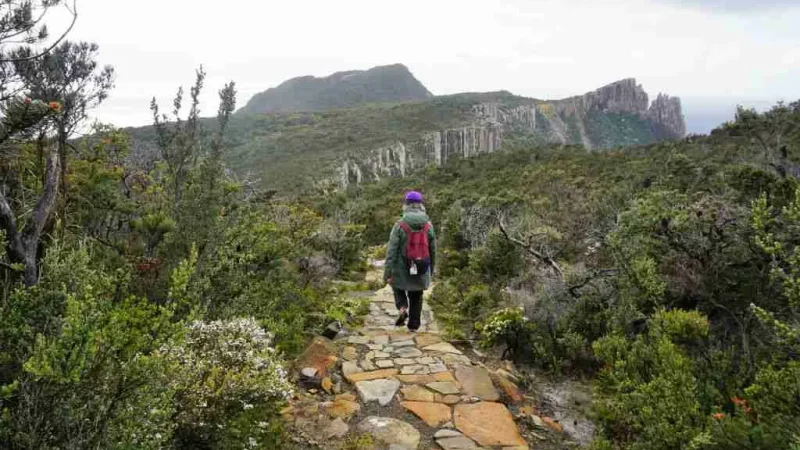Tasmania Travel Itinerary 10 Days: Tasmania, Australia’s island state, is a destination of breathtaking landscapes, unique wildlife, and rich cultural heritage. With its mix of rugged mountains, pristine beaches, and charming towns, Tasmania offers a diverse travel experience that’s perfect for adventurers, nature lovers, and history buffs alike. If you’re planning a trip to this captivating island, a well-thought-out itinerary can help you make the most of your time. In this guide, we’ll take you through a comprehensive 10-day itinerary, covering the must-see attractions and hidden gems of Tasmania.
Day 1: Tasmania Travel Itinerary 10 Days: Arrive in Hobart and Explore the Capital
Hobart is the perfect starting point for your Tasmanian adventure. As the capital city, it offers a blend of historic charm and modern vibrancy. Start your day by visiting Salamanca Place, a lively area known for its sandstone buildings, art galleries, and cafes. If you’re visiting on a Saturday, don’t miss the Salamanca Market, where you can find local crafts, fresh produce, and delicious street food.
After exploring Salamanca, head to Battery Point, one of Hobart’s oldest and most picturesque neighborhoods. Stroll through its narrow streets lined with colonial-era cottages and enjoy the views of the Derwent River. In the afternoon, visit MONA (Museum of Old and New Art), a world-renowned museum known for its provocative and contemporary art collections. End your day with a relaxing dinner at one of Hobart’s top restaurants, where you can savor local seafood and Tasmanian wine.
Day 2: Tasmania Travel Itinerary 10 Days: Day Trip to Bruny Island
On your second day, take a ferry from Kettering to Bruny Island, a haven for nature lovers and food enthusiasts. Start your exploration with a visit to The Neck, a narrow isthmus that connects North and South Bruny. Climb the stairs to the lookout for panoramic views of the island.
Spend the rest of the day indulging in Bruny Island’s gourmet delights. Visit local producers for tastings of oysters, cheese, and chocolate. Don’t miss a stop at Bruny Island Premium Wines, Tasmania’s southernmost vineyard, for a wine tasting experience. If you’re up for some adventure, take a wildlife cruise along the coastline to spot seals, dolphins, and seabirds.
Day 3: Discover the Tasman Peninsula and Port Arthur
On Day 3, drive to the Tasman Peninsula, home to some of Tasmania’s most dramatic coastal scenery and the historic Port Arthur. Start your day with a visit to the Tasman Arch, Devil’s Kitchen, and Blowhole, natural rock formations that showcase the power of the ocean.
Next, head to Port Arthur Historic Site, a former penal settlement and now a UNESCO World Heritage site. Take a guided tour to learn about the harsh conditions faced by convicts and explore the well-preserved ruins. In the evening, consider joining a ghost tour of Port Arthur for a spine-chilling experience.
Day 4: Drive to Freycinet National Park
On Day 4, set off early for Freycinet National Park, one of Tasmania’s most iconic destinations. The drive from Hobart takes about 2.5 hours, and you’ll want to arrive early to make the most of your day. Once you arrive, hike to the Wineglass Bay Lookout for one of the most famous views in Tasmania. The hike is moderate and takes about 1.5 hours round trip, offering stunning vistas of the crescent-shaped bay and turquoise waters.
If you’re feeling more adventurous, continue the hike down to the beach itself or opt for the longer Hazards Beach Circuit. In the afternoon, explore the park’s other attractions, such as Cape Tourville Lighthouse and Sleepy Bay. Spend the night in a nearby lodge or campsite.
Day 5: Visit Bicheno and the Bay of Fires
On Day 5, drive north along the coast to the charming town of Bicheno. This coastal town is famous for its penguin population, and you can book a penguin tour in the evening to see these adorable creatures up close.
Before night falls, continue your journey to the Bay of Fires, known for its white sandy beaches, crystal-clear waters, and orange lichen-covered rocks. Spend the afternoon relaxing on the beach, swimming, or taking a scenic walk along the coastline. The Bay of Fires is also a great place for snorkeling, with abundant marine life just off the shore.
Day 6: Explore Launceston and the Tamar Valley
On Day 6, drive inland to Launceston, Tasmania’s second-largest city. Start your day with a visit to Cataract Gorge, a natural formation just minutes from the city center. Enjoy a walk along the trails, take a ride on the world’s longest single-span chairlift, or simply relax in the gardens.
In the afternoon, take a drive through the Tamar Valley, one of Tasmania’s premier wine regions. Visit local wineries for tastings of cool-climate wines, particularly Pinot Noir and Riesling. Don’t miss a stop at Pipers Brook Vineyard and Jansz Tasmania, known for their sparkling wines.
Day 7: Visit Cradle Mountain-Lake St Clair National Park
On Day 7, travel to Cradle Mountain-Lake St Clair National Park, one of Tasmania’s most famous wilderness areas. The park is a hiker’s paradise, with trails ranging from easy walks to challenging hikes. The Dove Lake Circuit is a must-do, offering spectacular views of Cradle Mountain and the surrounding landscapes.
If you’re up for a more strenuous hike, consider tackling the Marion’s Lookout track for a panoramic view of the area. Wildlife enthusiasts should keep an eye out for wombats, echidnas, and Tasmanian devils. Spend the night in one of the park’s lodges or cabins.
Day 8: Explore the West Coast and Strahan
On Day 8, head west to the coastal town of Strahan, known for its rich history and stunning natural beauty. Take a cruise on the Gordon River, where you’ll be surrounded by ancient rainforests and mirror-like waters. The cruise often includes a stop at Sarah Island, a former penal colony with a fascinating history.
In the afternoon, explore the sand dunes of Henty Dunes or take a walk along Ocean Beach, one of the longest beaches in Tasmania. Strahan is also known for its theatre production, The Ship That Never Was, a lively retelling of an escape from Sarah Island.
Day 9: Travel to Mount Field National Park
On Day 9, make your way to Mount Field National Park, one of Tasmania’s oldest national parks. The park is home to the famous Russell Falls, a tiered waterfall that is easily accessible via a short walk from the visitor center. Continue your exploration with a walk to Horseshoe Falls and through the Tall Trees circuit, where you can marvel at some of the tallest trees in the world.
In the afternoon, drive up to the Lake Dobson area for a hike through the subalpine landscapes. The area is especially beautiful in autumn when the leaves of the Fagus, Tasmania’s only deciduous tree, turn a brilliant gold.
Day 10: Return to Hobart and Explore Surroundings
On your final day, return to Hobart and spend some time exploring any sights you might have missed. Consider a visit to the Royal Tasmanian Botanical Gardens, which features a wide variety of native and exotic plants. Alternatively, take a drive up to Mount Wellington for panoramic views of Hobart and the surrounding area.
If you have time, explore the Huon Valley, located just south of Hobart. The valley is known for its apple orchards, vineyards, and scenic landscapes. Visit a local cider house, take a walk through the Tahune Airwalk, or simply enjoy the tranquil beauty of the region. End your Tasmanian adventure with a final meal in one of Hobart’s acclaimed restaurants, reflecting on the incredible experiences of the past ten days.
Conclusion
Tasmania Travel Itinerary 10 Days: A 10-day journey through Tasmania offers a rich tapestry of experiences, from exploring historic sites and hiking through pristine wilderness to indulging in gourmet food and wine. This itinerary is designed to give you a taste of everything Tasmania has to offer, ensuring that your visit is both diverse and memorable. Whether you’re seeking adventure, relaxation, or cultural exploration, Tasmania delivers it all in a uniquely beautiful package.
FAQs
1. When is the best time to visit Tasmania?
The best time to visit Tasmania is during the summer months (December to February) when the weather is warm and ideal for outdoor activities. However, spring (September to November) and autumn (March to May) also offer pleasant weather and fewer crowds.
2. Is it easy to drive around Tasmania?
Yes, driving is the best way to explore Tasmania. The roads are generally well-maintained, and having a car gives you the flexibility to visit remote areas and travel at your own pace.
3. Do I need a National Parks Pass in Tasmania?
Yes, if you plan to visit Tasmania’s national parks, you will need a Parks Pass. You can purchase a pass at the park entrances, visitor centers, or online before your trip.
4. Are there any dangerous animals in Tasmania?
Tasmania is relatively free of dangerous animals. However, it’s essential to be cautious when hiking or camping, particularly with regards to snakes, which are venomous but generally avoid human contact.
Also read: Travel Bag for Car Seat: 10 Hacks for Stress-Free Family Trips









